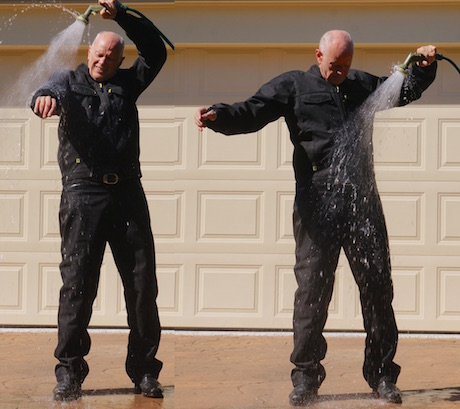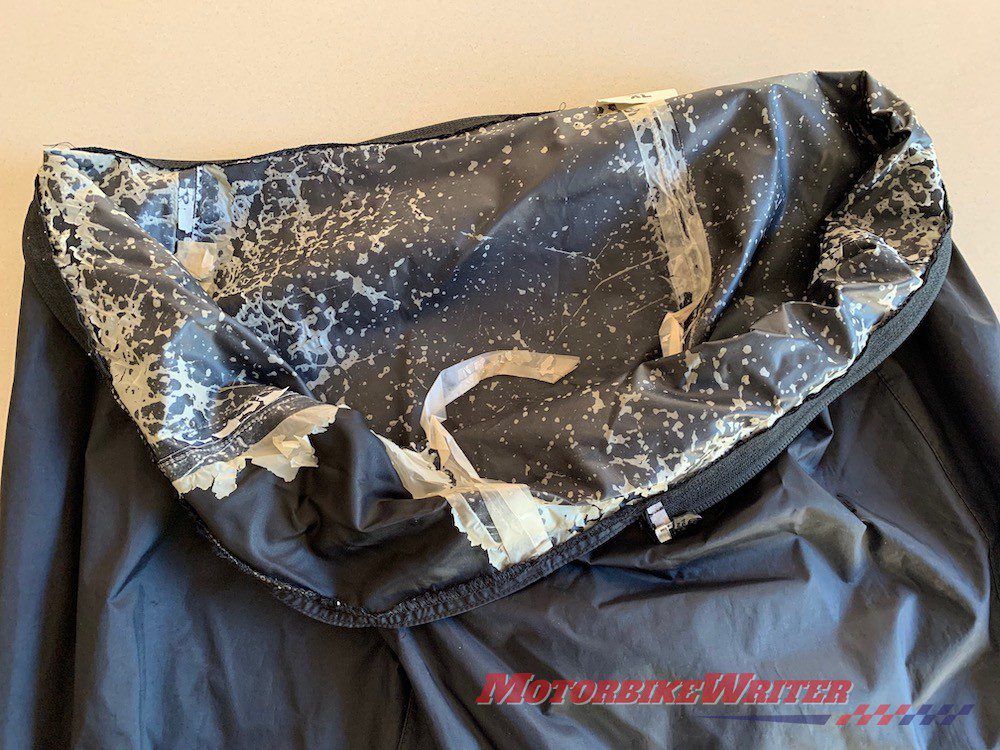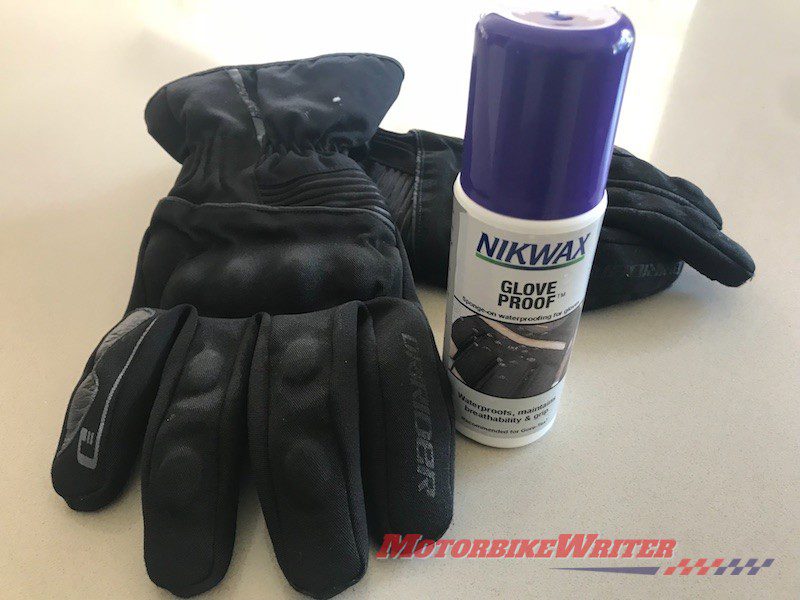Have you ever found out the hard way that waterproof gear has a use-by date after which it is totally useless?
Two pairs of boots, two pairs of gloves, a jacket and several pair of pants have failed me after as little as five years of periodic use.
This is despite the fact that I look after my gear and store it in a cool, dry cupboard.
Waterproof warranty
I’ve checked all my waterproof gear and none offers a lifetime guarantee.
Also, note that “weatherproof”, “water-resistant” and “water-repellent” are not the same as “waterproof”. These terms mean the garment is rarely watertight even in light showers when you are riding.
And check whether it says the gear is 100% watertight. Some may also include an Ingress Protection (IP) rating.
This rating consists of two numbers. The first from 0-6 measures protection from foreign bodies such as dust, while the second from 0-9K measures resistance to water. Click here for more details.
Also note that your supposedly waterproof gear may only be guaranteed to be impervious to water in some areas or just have watertight pockets.
Waterproof warranties are typically the same as the garment which is usually from one year to about three years.
Manufacturers could fit jackets and pants with more robust and heavier waterproof membranes and offer longer warranties.
However, that would impact on comfort, weight and price.
So it’s important to look after your waterproof gear.
Failures
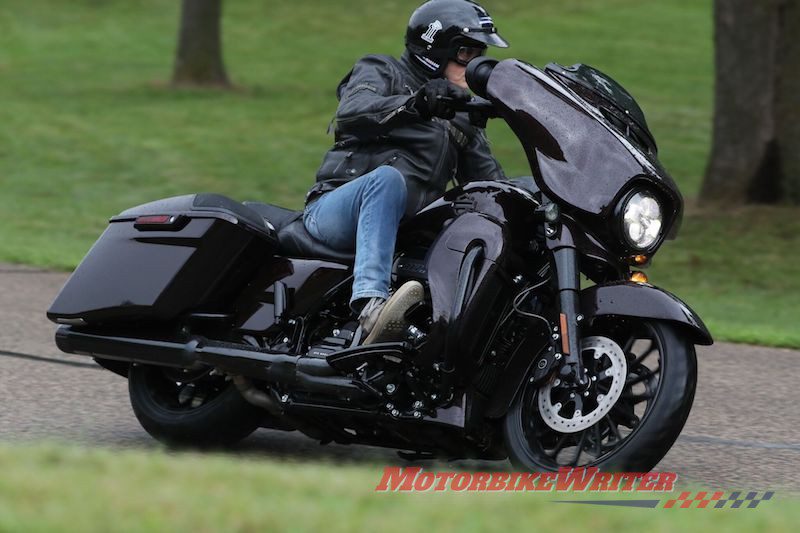
One of the main problems with waterproof failures is that you may not notice a fault in your gear when you put it on.
You only find out when you go for a ride and get caught in the rain.
And even the most minor fault, crack or split can suck in moisture when you are riding at highway speeds!
There can be a number of reasons for waterproofing failures:
- Waterproof leather gear is usually the first to give in because it can age and crack;
- Boots can develop minuscule cracks in the soles from simply walking around in them;
- Racing boots with bolt-in toe sliders can become loose as they repeatedly hit the ground, allowing in water;
- Waterproof pants can develop small tears in the lining or you can dislodge the glued-on taped seams if you pull them on while wearing your boots;
Waterproof pants lose their taped seams and lining from years of use - Folding waterproof garments can cause them to wear and split at the creases;
- Carrying waterproof gear on your bike scrunched up on a rack and secured by Occy straps can cause rips and wear;
- Gore-Tex pants and jackets should last a long time, but the outside layer can get worn from rubbing in areas such as the armpits, crutch and backside;
- Zippers can become rusted from rain and road grime and even waterproof zippers can become gummed up by dust and bugs; and
- Machine washing your gear can remove or destroy the watertight capabilities of some materials.
Waterproof care
King Canute found he could not hold back the tide and maintaining waterproof riding gear can be similar.
However there are some things you can do:
- Boots will last longer if you only wear them on the bike and do limited walking.
- Regular treatment of leather with shoe polish, special softeners and waxes such as Dubbin may help prolong their waterproof life;
- Take your boots off before pulling on waterproof overpants;
- Re-spray your textile gear with waterproof sprays;
- Store your gear in a cool, dry cupboard;
- Hang your jackets and pants and never fold them;
- Always allow wet gear to dry in a well-ventilated area out of direct sunlight before storing;
- Carry waterproof gear in a safe place in your backpack or bike luggage, preferably rolled up, not folded;
- Give zippers an occasional spray with silicon or rub them with an appropriate wax to help the zipper slide smoothly and last longer; and
- Leather gear requires special attention. Click here for our comprehensive tips on how to look after your leather gear.
Washing
Riding in the rain or even doing water crossings not only get your gear wet, but also dirty.
So you should periodically wash your gear before storing it away.
When washing your gear, always follow the manufacturer’s instructions. They usually stipulate a hand wash or gentle, warm-wash machine cycle.
Long, hot machine washing cycles can limit the waterproofed life of a garment.
Never use fabric softener when washing and most manufacturers warn against tumble drying or ironing.
However, note that some materials, such as Gore-Tex, actually require tumble drying or ironing after washing to restore their waterproof qualities. Watch this instructional video.
User error
Sometimes it’s not the gear that fails, but the rider, says Link International product manager Ron Grant.
“The majority of wet claims I believe are mainly due to incorrect usage or fitment,” he says.
“You can have the best jacket in the world, but if you don’t get all the closures correctly positioned, ensure your shirt collar or cuffs aren’t exposed (which creates a wicking point for water entry) you will still get wet.
“If you wear gloves over your cuff, water penetrates through the jacket stitching in the chest and arms, runs down between the outer shell and the outside of the waterproof liner (so the rider is still dry) and drains straight into the gloves. This is not a glove issue but a rider fitment issue.
“Likewise with waterproof boots. I see riders buy ‘shorty’ waterproof boots and then complain they get wet feet.
“If you have a look at their rain pants when their feet are on the pegs, the rain pants may ride up just enough to allow water into the boots.”
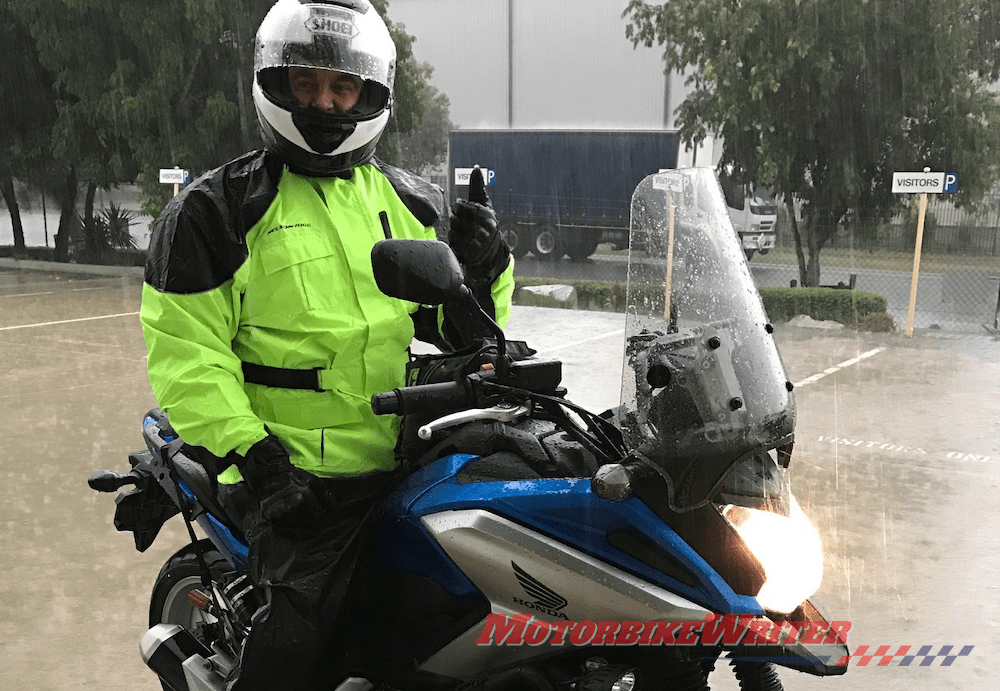
Ron warns that water will finds its way into that 1% vulnerable area in your whole riding ensemble and spoil your ride.
He says he left for work recently in the pouring rain on his Triumph Tiger 800 fitted with a new, large touring screen to protect him from the elements.
“This new screen creates a bit of a vacuum between the screen and I could see water droplets swirling around in front of me around my throat area,” he says.
“I didn’t really think about this too well, but I had pulled my neck-sock on before fitting my jacket as it’s more comfortable that way.
“The droplets eventually soaked my neck-sock which wicked the water downwards wetting my jumper and shirt. My waterproof jacket didn’t fail, it was the dummy wearing it that failed!”


